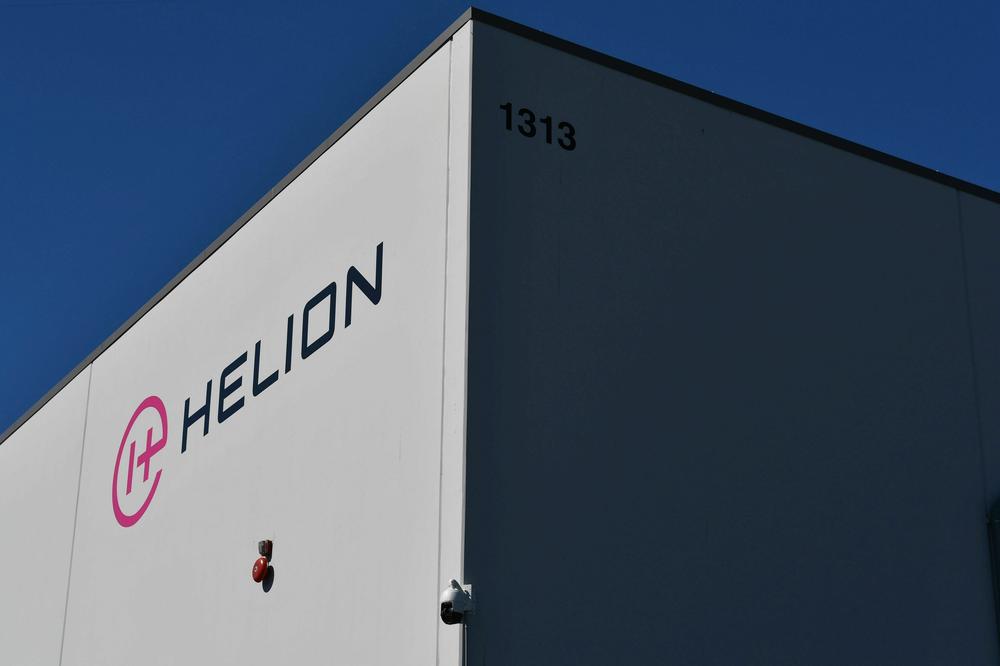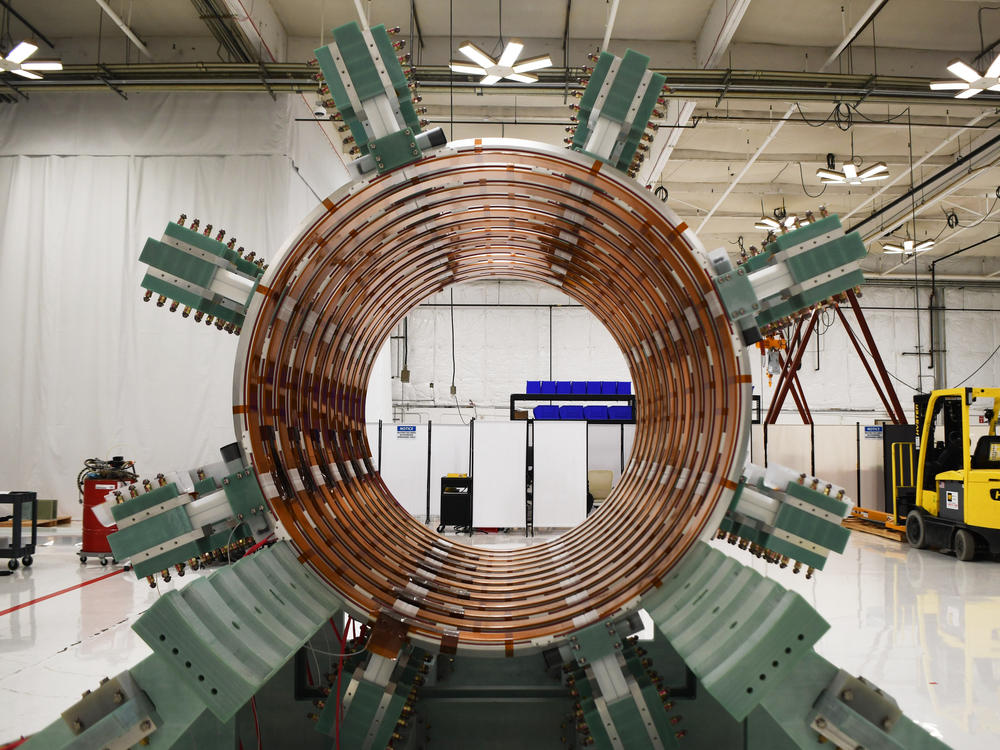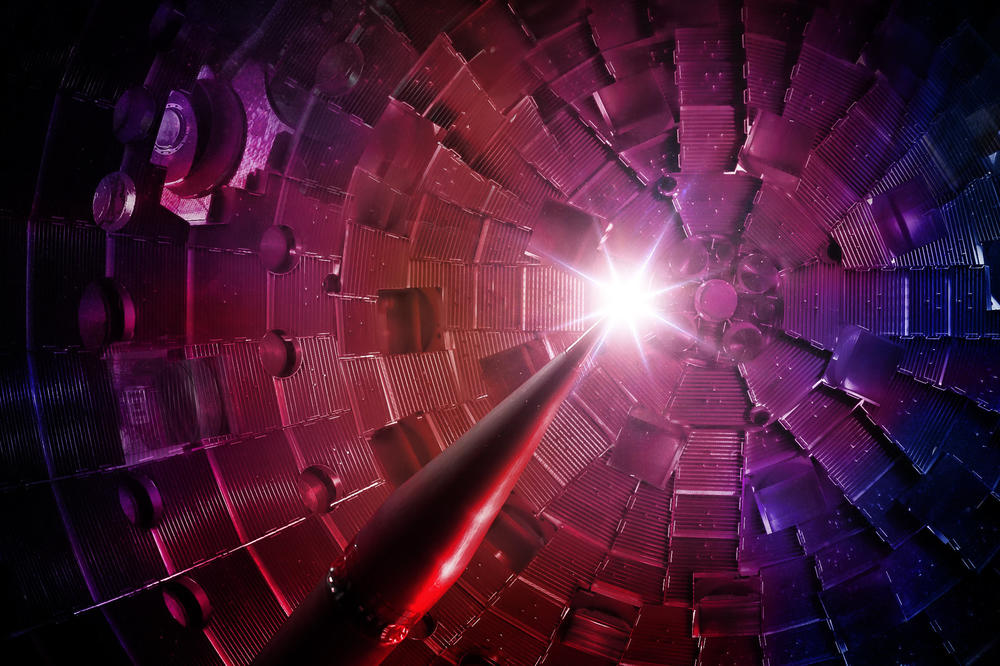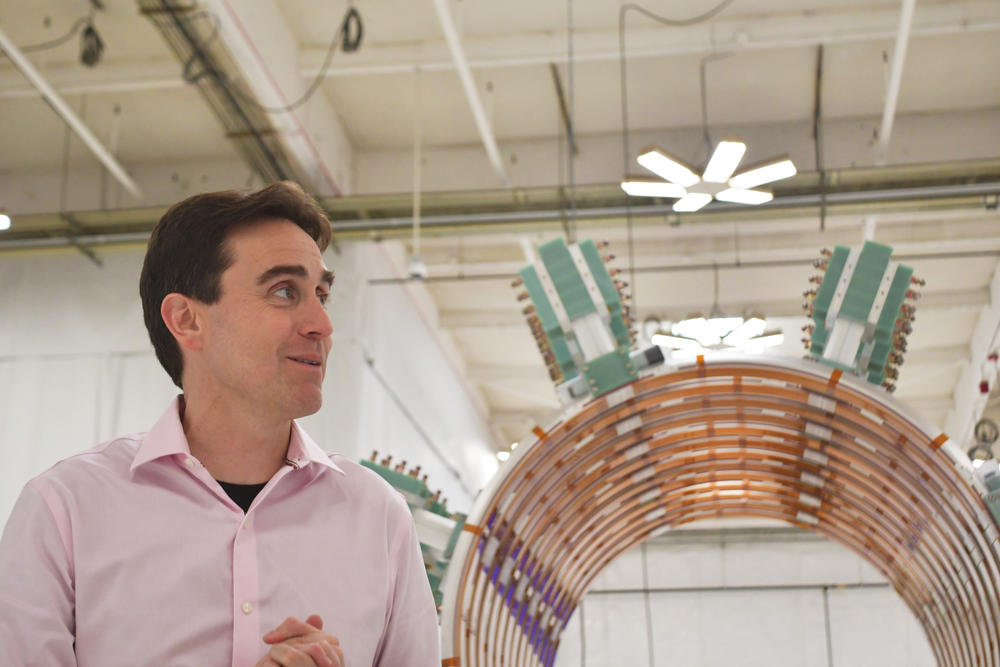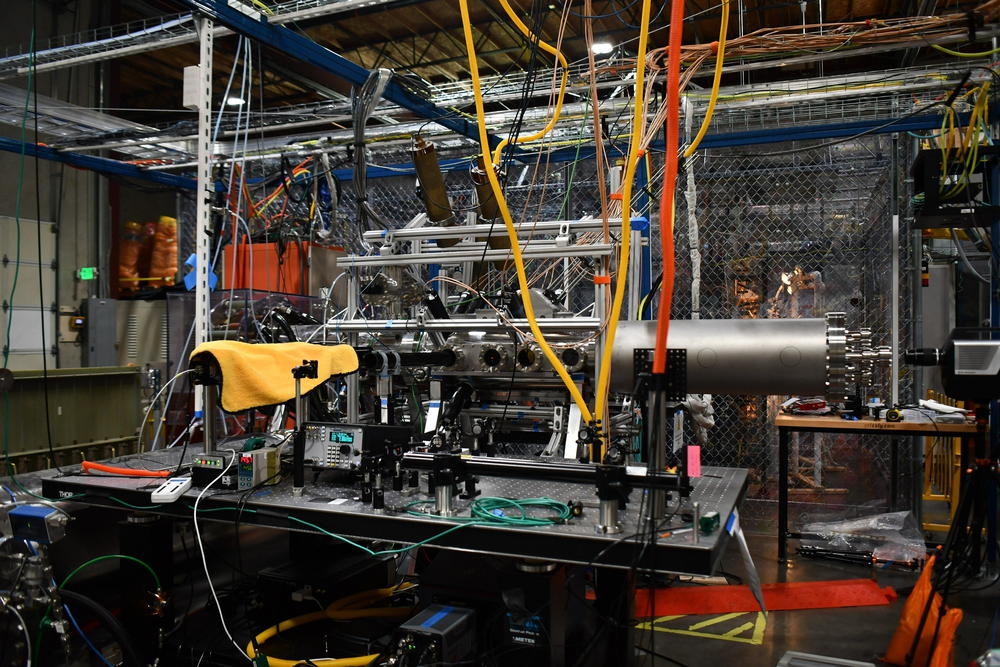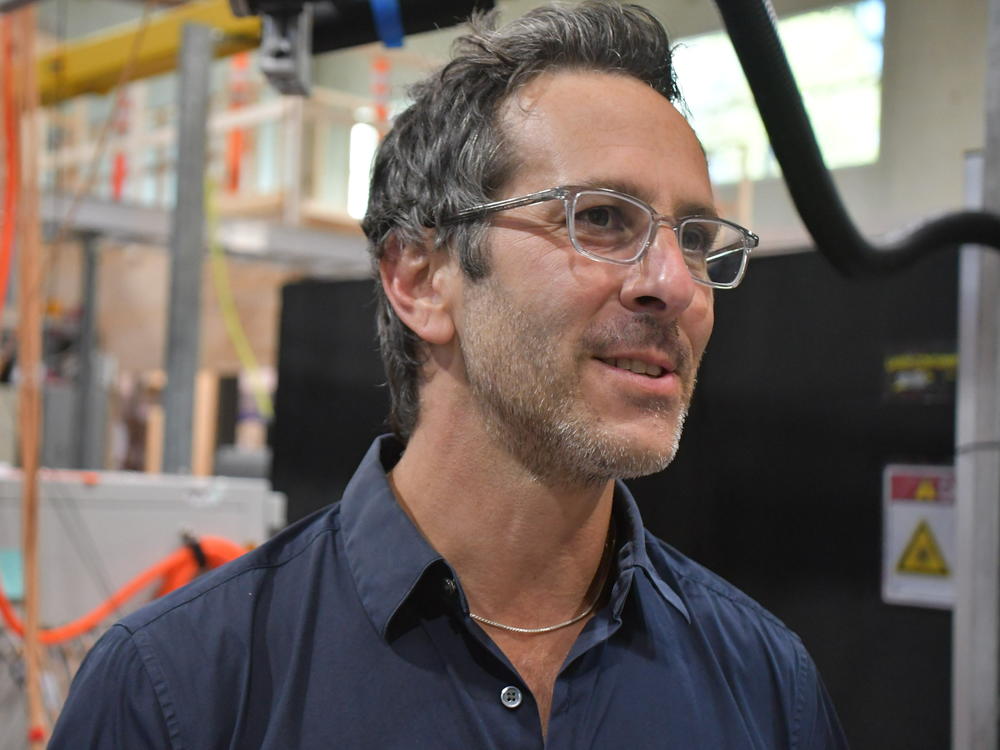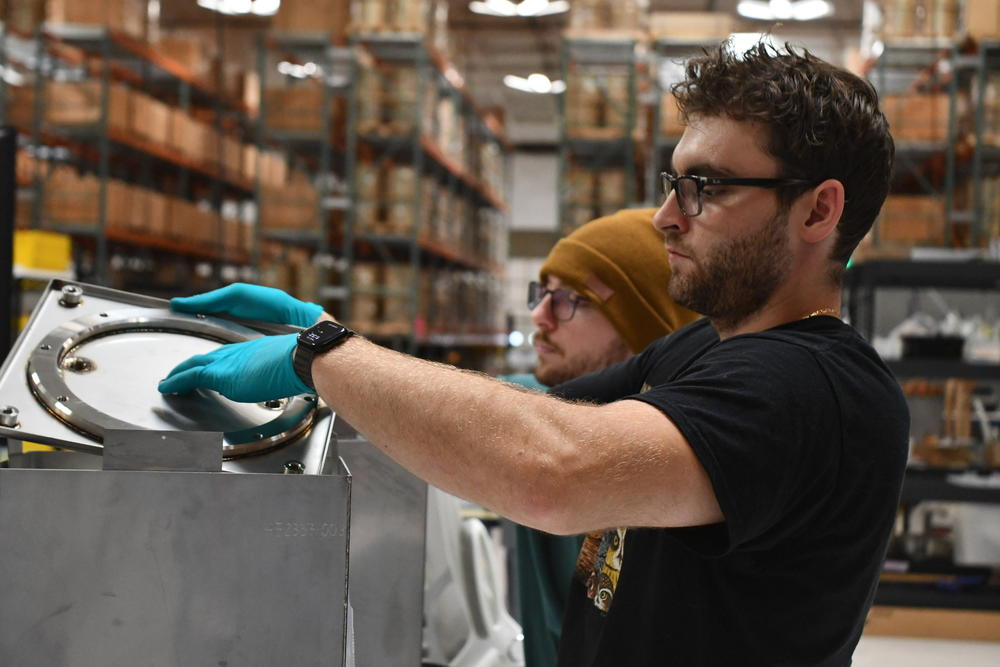Section Branding
Header Content
Companies say they're closing in on nuclear fusion as an energy source. Will it work?
Primary Content
In a gleaming warehouse complex north of Seattle, David Kirtley is building what he hopes will be the future of power generation.
Standing in front of a set of aluminum coils that look like an advanced engine for some yet-to-be-built starship, Kirtley makes the case for his project that he's made to venture capital firms and wealthy private investors:
Fusion power could change the world. If it worked, it would grant humanity eye-watering quantities of electricity without producing any greenhouse gas emissions. The warming of the planet would slow, environmental pollution would drop, and energy would be cheaper than ever.
"We can generate electricity, theoretically, at much lower costs than we currently generate it now," he says. "And do it without fossil fuels."
The pitch has worked. In its last major fundraising round in November of 2021, Kirtley's company, called Helion, raised an impressive $500 million. That money came from investors like Sam Altman, the CEO of OpenAI, who has shown an active interest in investing in nuclear fusion and fission as potential forms of clean energy for the future.
Now Helion's more than 200 employees are working at breakneck pace to try and build the world's first commercial fusion power plant. They hope their newest machine, currently under construction, will produce electrical output by the end of 2024 and net energy in a matter of years.
To call that goal ambitious is a spectacular understatement. Nuclear fusion is the process that powers stars like the sun. In the 1950s and '60s, governments poured money into research, hoping for clean, essentially limitless energy here on Earth.
So far, bottling the power of stars for human consumption is looking much harder than scientists anticipated. Government laboratories have put in decades of work trying to get fusion power on the grid. But those efforts have been plagued by false starts, broken promises and gargantuan cost overruns.
A grim joke has taken hold in the field: Fusion is the energy of the future — and it always will be.
Helion, and a handful of other companies, are hoping to shift that view by generating fusion on a scale of years, rather than decades. It should be possible, they say, in part because of the long-running public investment in fusion research, and because new technology and equipment can be brought to bear on the problem.
For investors, the payoff could be enormous. Electricity demand is expected to surge globally in the coming decades, in part due to an increased reliance on greener technologies such as electric vehicles and appliances. Meanwhile, the planet's only hope for stopping global warming is to do away with fossil fuels. On Tuesday, at the United Nations climate summit in Dubai, U.S. climate envoy John Kerry is expected to lay out a strategy for trying to commercialize fusion power worldwide.
Whichever company can make its fusion technology work would likely earn a valuation that would rival the biggest Silicon Valley firms today.
A sticky business
Nuclear power plants today use a process called fission, which harvests the energy released by breaking heavy atoms apart. Nuclear fusion does the opposite: It generates energy by sticking lightweight atoms together. When the atoms stick, they create new elements and particles that weigh less than the total mass of the originals. That missing mass is converted to energy, via Einstein's famous equation E=mc2. It's that conversion from mass to energy that makes fusion among the most powerful processes in the universe.
It's also tricky. The cores of atoms, known as nuclei, are positively charged. Like the north ends of two magnets, these positive charges repel one another as they get close — and the closer they get, the more the tiny atoms swerve and bounce trying to avoid each other. It's only in the hottest and densest environments in the universe that the atoms can overcome this powerful repulsion and actually stick. The most common place this happens is in stars, including our sun.
"Basically, the sun weighs so much that it's able to squeeze these atoms together and fuse them," says Carolyn Kuranz, an associate professor of nuclear engineering at the University of Michigan. The sun works primarily by fusing hydrogen into helium, but other stars fuse heavier elements, including carbon, nitrogen, oxygen and lithium — and even iron. "Actually, that's how the iron in our blood was generated," Kuranz says — by other stars that, upon their deaths, sent these heavier elements out into the universe.
Back here on Earth, without the aid of a crushing gravitational field, fusion becomes a much trickier task. The fusing atoms must be heated to high temperatures and held close enough together that they can overcome their repulsion. In the process, they cannot interact with their container or touch anything around them — otherwise they'll cause it to melt.
"Imagine putting the sun inside some sort of gas tank," she says.
In fact there's only been one device ever made that can produce net fusion energy — the thermonuclear bomb. It uses the energy of a "smaller" nuclear fission device to crush hydrogen into helium. The entire process happens in just a fraction of a second, and once the fusion reactions start, there's no hope of containment — the first hydrogen bomb ever tested vaporized the island it was detonated on.
The goal of fusion scientists is to build a device that could harness all that power to safely generate a steady current of electricity. For decades they have been pursuing two approaches. One, known as magnetic confinement, requires suspending the hot plasma inside a magnetic shell. It's a tough approach, and it requires a large vessel that can hold the hot gas without touching it. Currently, nations from around the globe are trying to build just such a machine in the south of France. It might someday generate net power, but it is years behind schedule and billions of dollars over budget.
The other approach, known as inertial confinement, uses lasers to squeeze tiny pellets of hydrogen fuel until they start a runaway fusion reaction. The process is not unlike a nuclear weapon, and that's why the first successful test to produce net power took place at a nuclear weapons laboratory.
Last December, researchers at the Lawrence Livermore National Laboratory's National Ignition Facility used an array of 192 lasers to squeeze a tiny frozen pellet of fusion fuel until it burst. The energy from the pellet was greater than the power put in by the lasers, marking a major milestone for fusion as an energy source.
Despite that success, researchers like Kuranz conceded the technique faces huge engineering challenges before it can be commercially viable. "There's a lot of steps in between that it would take to get to electricity," she says. To create a steady flow of fusion power would require the lasers to zap a tiny target "many times a minute or even many times a second," she says. And the lasers would have to be many times more efficient than the ones used at the facility — they gobbled up megajoules of electricity to produce the laser light needed to squeeze the pellet.
Getting on the grid
For Helion's David Kirtley, the ponderous scientific approach that governments have taken to fusion is frustrating. "Early in my career, I wanted to solve big problems in the Universe; big problems for humanity," he says. But as he progressed through a Ph.D. in physics, he discovered that "the approaches for fusion I was learning about in school weren't actually going to turn on and generate electrons on the grid in my lifetime."
Helion was founded in 2013 with a single goal — to put fusion power on the grid. As we walk through the company's manufacturing facility, Kirtley explains how it works. Helion's design is basically a long tube of magnetic coils. At each end of the tube, the process starts with the injection of a small quantity of hydrogen and helium gas. That gas is heated until the atoms lose their electrons, creating a doughnut of hot, glowing fuel known as a plasma. The plasma doughnuts at each end are then sent to the center of the device, where they collide and are crushed by additional magnetic fields.
The machine rapidly squeezes the fuel to over 100 million degrees and pressures above 250 atmospheres, allowing the helium and hydrogen to fuse. "When fusion happens, it pushes back on the magnetic field," Kirtley explains. "We directly recover electricity from the magnetic field."
It's a bold and potentially highly efficient way to generate electricity from fusion, but it's also enormously challenging. The hot plasma gases struggle to escape their magnetic confinement, and getting the hydrogen and helium to stick requires an enormous amount of heat and compression — more so than other kinds of fusion fuels.
Researchers had struggled to make similar designs work during the early days of fusion research, but Kirtley thinks the concept deserves a second look. High-speed electronics, fiber optics and advanced, solid-state switches all make it possible to heat and compress the fusion fuel much more quickly than in the past — lessening the time it has to escape from its magnetic confines. "The faster we go, the more we can compress it, the more we can heat it, the more fusion we can get out of it," he says.
The company has already built six generations of devices, showing steady improvement. Kirtley says he believes the next machine, known as Polaris, will be able to produce more electricity than it requires — a crucial milestone known as "break even." Polaris, which is under construction in the next warehouse over, is expected to begin operation in 2024. Kirtley believes that they will prove they can extract electrical power from the device by the end of next year, though it's not clear whether the power out will exceed the power in.
Billions in investment
Helion is hardly the only game in town: In fact, just five minutes up the road, a rival startup is trying a different approach. The company, known as Zap Energy, uses another system known as a Z-pinch to try and generate power. Zap's concept is simpler than Helion's — a current is driven through the fusion fuel, heating it up. The same current generates a magnetic field around the fuel that squeezes it.
"I don't want to call it 'just a lightning bolt,' because that makes it sound simple," says Ben Levitt, the vice president of research and development at Zap. If the fuel can be heated and squeezed quickly and strongly enough, then the fusion it produces should exceed the energy put in.
Like Helion, Zap's concept isn't new — government researchers tried to make it work in the 1950s, but ran into trouble keeping the synthetic lightning bolt from breaking apart before fusion occurred. New research in the 1990s suggested a way around the problem, and Zap is now close to showing, at least in principle, whether it can produce fusion power. The company is funded with $200 million in venture capital from large corporations, including Chevron and Shell.
Private capital has been flowing into fusion research in recent years, with new investments topping $2.8 billion in 2022, according to the Fusion Industry Association, a fusion trade group. Some 25 companies are now operating in the U.S., and they're pursuing a wide variety of designs — some use lasers to squeeze the fuel, like the large government experiment that just had a breakthrough, while others use magnets to hold the fuel in a doughnut shape.
Levitt says that the private money is allowing researchers like him to work in a different way. "There's no red tape, we're properly funded for making bold decisions on engineering," he says. "That's the thesis of the private fusion company."
The attraction for investors is fairly simple. "Fusion is the ultimate energy source," says Phil Larochelle, a partner at Breakthrough Energy Ventures, a private venture capital firm that's investing in four fusion companies, including Zap. Fusion is far more efficient than chemical energy sources like oil and gas. "It's got a million-fold improvement in energy density over what we use now, and also if we can get it to work it's basically infinite, free, accessible to all, and if we get it right, carbon-free," he says.
"Abundant intelligence and abundant energy are two of the most important inputs to a much better future," Sam Altman, the CEO of OpenAI and an investor in Helion, told NPR via text message. Helion, he says, is "great tech for cheap clean safe energy (and lots of it)."
Larochelle says the moment is ripe for private industry to back a breakthrough, largely because of decades of government work that's been done to advance fusion science.
"It's too bad that the line 'Fusion is 30 years away and always will be' is so catchy," he says. "In fact, there's been a huge amount of progress in fusion, starting in the 1960s."
And the government is attempting to bootstrap the current commercial interest. In May, the U.S. Department of Energy announced it would invest $46 million into eight companies, including Zap, to try and speed the development of commercial fusion power.
The current moment "is very exciting," says Anne White, professor of nuclear science at MIT. "We've always had basic research, but we didn't have companies and private investors being willing to take a lot of that and translate it."
Rushing toward the goal
The sprint is now on to see whether these new takes on old approaches can work. While neither Helion nor Zap was willing to provide an exact date for when their devices might produce net power, both spoke in terms of a year or two, as opposed to decades.
But can they actually do it?
"I think that's to be determined," says Carlos Paz-Soldan, an associate professor of applied physics at Columbia University in New York. With fusion, the devil has always been in the details. Things like turbulence in the hot plasma gas can cause it to leak out before fusion occurs. And sometimes instabilities turn up unexpectedly as devices increase in size or power.
Paz-Soldan says the current spike in private investment came at the end of the pandemic, when debt was cheap. "When interest rates were low, people were willing to make long-term bets," he says.
He does believe the large quantity of money that has flowed privately into fusion will advance the field. "The level of investment was substantial, and it should yield technological progress," he says. But with interest rates high again, investor willingness to take risks going forward will be lower. If companies can't show significant progress, he thinks they may not be able to raise more money in future rounds. Indeed, the latest report from the Fusion Industry Association showed that new investment was down substantially in 2023.
White says she's optimistic that the current sprint in private industry will produce results. While getting electricity on the grid may take a while, she believes that one of several compact systems will soon produce more energy than it consumes: "I think in five years we're going to see it," she says. "I really hope we do."
Back at Helion's manufacturing facility, Kirtley is aware of the headwinds facing an advanced technology company like his, but he's also optimistic about the future. Helion's last funding round raised enough money to complete construction of its current machine and begin work on the full design of a power plant.
There's an old quote in the field, he says: "We will have fusion when the world needs fusion."
The world has never needed it more than it does today, Kirtley argues — and he hopes that his company will be the one that delivers.
Copyright 2023 NPR. To see more, visit https://www.npr.org.
